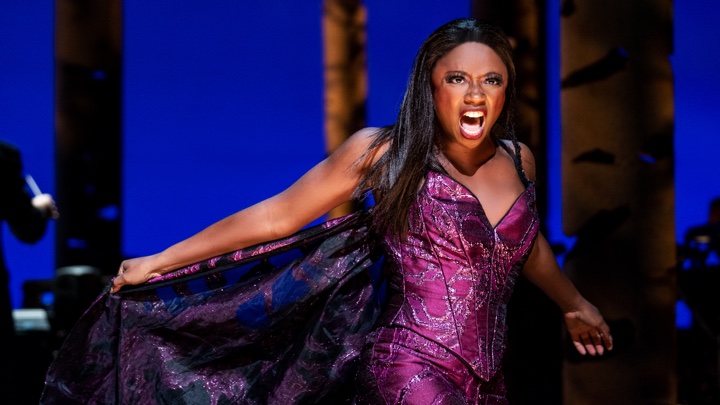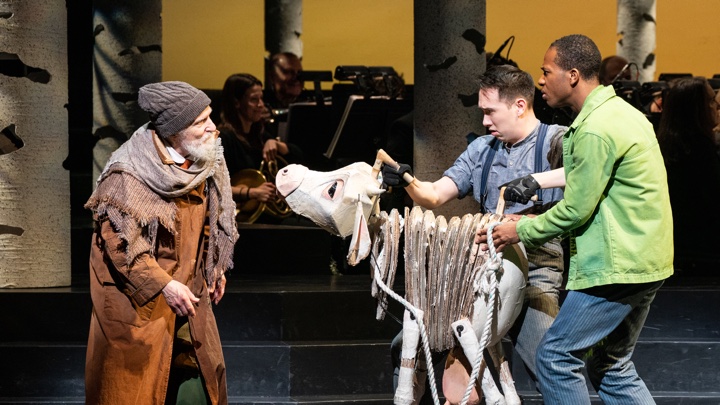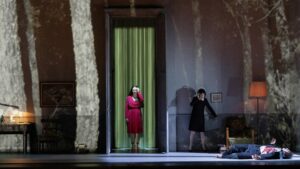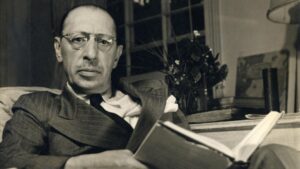
Or do you tune into a darker underlying message, heavily influenced by Bruno Bettelheim‘s The Uses of Enchantment, a landmark work of psychological interpretation that contextualizes and connects multicultural fables as metaphors and modes by which children come to understand life’s harsh truths? Though often focused on youth, this is a very adult theme.
I saw the Broadway original when it was still in previews, and thought it tipped too far into winky faux naivete, though the video of that production, made later in the run, is better. It also preserves some treasurable performance, in particular Chip Zien and Joanna Gleason as the Baker and Wife, and Danielle Ferland, for me the definitive Little Red.
I should also say from the start that I’m definitely in Camp #2–Bettelheim over Grimm. For me, Into the Woods is primarily about the loss of innocence. We associate that phrase with children and childhood, but truly it’s a phenomenon that happens throughout the life cycle. We also associate the idea with sadness and loss, but it isn’t always–the awakening of sexuality is a loss of innocence that should be thrilling and joyful.
However you view it, Into the Woods chronicles multiple experiences at multiple life stages, and it’s a mixed bag for sure. Several main characters don’t make it to the final curtain; those who do are older and wiser.
In any case, there’s no doubt the show needs to function on multiple levels. But finding the right tone and balance is a major theatrical challenge for the whole team: director, designers, and especially performers. I can think of few musicals where the acting challenges are trickier. If I were directing, ideas I would want the cast to explore include tartness and sardonic wit (to counteract material that tends to extremes of farce and mawkishness), centeredness (because the characters are by nature archetypal and even cartoonish), and sincerity (because, well–all shows need that).
By those standards, the touring production I saw last night–rapturously received in Philadelphia by what looked like a capacity crowd–never got out of the gate.
To be fair, this is a show where the musical values are quite strong. The cast, though over-amplified, all sing well to very well; the orchestra, though sometimes sounding tinny in the cavernous acoustic of the Miller Theatre, play well.
But on a theatrical level, it’s a different story.
A few performances really hit home. Sebastian Arcelus is very moving as the Baker, imbuing the character with a heart-rending Everyman kind of pathos. Diane Phelan is a lovely Cinderella both vocally and in terms of unmannered charm. In Act II, Montego Glover‘s Witch found a sense of dignity that I’ve not seen previously in this role. You can probably read between the lines, but I’ll make it explicit: All three of them shared that they kept schtick to a minimum, focusing instead on simplicity.
If only the rest came close. From the opening moments, I had the sinking sensation that we were watching a company that would push for cheap laughs at virtually any cost. Gavin Creel as the Cinderella’s Prince and the Wolf and Katy Geraghty as Little Red are grotesquely milking the audience, killing any possibility that we might actually take this material seriously.
Little Red is especially problematic in Into the Woods, but her awakening sexuality with Jack (attractively sung but ineffectually acted by Cole Thompson) can be a wondrous moment. Here, it’s a joke.
“Moments in the Woods,” which for me is almost always a highlight of Into the Woods is killed here when Creel and Stephanie J. Block as the Baker’s Wife do a vulgar mocking pantomime of sexual attraction, rather than actually connecting. Block is particularly frustrating to me. A fabulously gifted singer, she masters the vocal aspects of the Baker’s Wife as well as anyone. But she hasn’t found her heart and soul.
The production itself doesn’t help. Director Lear deBessonet originally mounted it in May 2022 at Encores! The intersection with emergence from COVID quarantine made it feel very resonant, and a rapturous New York Times review helped extend the show to Broadway and now beyond. Under those conditions, the very pared down staging, with the orchestra taking center stage, worked fine. It also looked better in the City Center space, where it was also played with more nuance.
Seen here, the show looks cheap. Design choices make little sense together. The costume styles run a gamut that feels like they were pulled from different productions, while the minimalist scenic elements are in another world entirely. DeBessonet’s better ideas–including the use of some lovely puppetry–largely get lost in the morass.
Full disclosure: Sondheim devotee that I am, I’m an Into the Woods agnostic. The basic idea is brilliant, and there are sections that knock me out. “No More” would be in my absolute top group of Sondheim songs. But the work is very uneven, hyperextended, and ultimately disappoints with a pat, simplistic conclusion… and its flaws are mercilessly exposed in this production.
Your mileage, as they say, may be different. If you see it, I hope you enjoy it–or, as Into the Woods would have it, “I wish!”
Photos: Matthew Murphy and Evan Zimmerman







Comments